The global glass rolling forming machine market is forecasted to reach USD 109.0 million by 2035, recording an absolute increase of USD 41.5 million over the forecast period. The market is valued at USD 67.5 million in 2025 and is set to rise at a CAGR of 4.9% during the assessment period. The market size is expected to grow by nearly 1.6 times during the same period, supported by increasing demand for precision glass manufacturing in building materials and automotive sectors, driving adoption of advanced forming technologies and expanding investments in glass production facilities and industrial manufacturing operations globally.
The market expansion reflects growing requirements for specialized forming equipment in glass manufacturing applications, where Glass Rolling Forming Machines deliver superior shaping capabilities and production efficiency compared to conventional glass forming methods. Manufacturing facilities across building materials production, automotive glass manufacturing, and electronic display fabrication are implementing Glass Rolling Forming Machines to achieve enhanced precision outcomes and improved manufacturing consistency. The integration of these specialized forming systems with modern production processes enables manufacturers to reduce material waste by 35-50% compared to traditional forming approaches while maintaining quality and dimensional accuracy requirements.
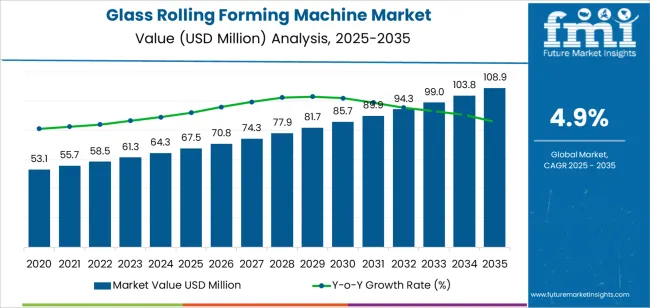
The market demonstrates strong momentum across developed and emerging manufacturing economies, where glass industries are transitioning from conventional forming methods to advanced machinery systems that offer superior performance characteristics. Glass Rolling Forming Machine technology addresses critical manufacturing challenges including dimensional precision optimization, production speed consistency, and material utilization across extended production cycles. The building materials sector's shift toward high-performance glass products and specialized architectural applications creates steady demand for forming solutions capable of processing various glass types and thickness requirements with minimal processing complexity and consistent quality output.
Glass manufacturers and industrial producers are investing in glass rolling forming machine systems to enhance competitive positioning through improved manufacturing precision and expanded production capabilities. The integration of advanced control technologies and optimized forming configurations enables these machines to achieve manufacturing standards 40-60% higher than conventional systems while maintaining cost-effectiveness performance. The initial capital investment requirements for specialized forming equipment and technical expertise barriers for optimal process optimization may pose challenges to market expansion in cost-sensitive manufacturing segments and regions with limited access to advanced glass production resources.
Between 2025 and 2030, the market is projected to expand from USD 67.5 million to USD 85.8 million, resulting in a value increase of USD 18.3 million, which represents 44.1% of the total forecast growth for the decade. This phase of development will be shaped by rising demand for precision glass forming in building materials and automotive applications, product innovation in forming technology and control systems, as well as expanding integration with advanced manufacturing platforms and automated production lines. Companies are establishing competitive positions through investment in advanced forming machinery, precision optimization technologies, and strategic market expansion across building materials manufacturing, automotive glass production, and electronic display fabrication operations.
From 2030 to 2035, the market is forecast to grow from USD 85.8 million to USD 109.0 million, adding another USD 23.2 million, which constitutes 55.9% of the overall ten-year expansion. This period is expected to be characterized by the expansion of specialized forming systems, including advanced directional configurations and multi-functional machine designs tailored for specific glass types and application requirements, strategic collaborations between machinery manufacturers and glass producers, and an enhanced focus on automation optimization and production efficiency enhancement. The growing focus on manufacturing precision and material utilization will drive demand for advanced, high-performance Glass Rolling Forming Machine solutions across diverse glass manufacturing applications.
| Metric | Value |
|---|---|
| Market Value (2025) | USD 67.5 million |
| Market Forecast Value (2035) | USD 109.0 million |
| Forecast CAGR (2025-2035) | 4.9% |
The Glass Rolling Forming Machine market grows by enabling manufacturers to achieve superior glass forming precision and production efficiency while reducing material waste in diverse manufacturing operations. Glass manufacturing facilities face mounting pressure to improve product quality and production consistency, with glass rolling forming machine systems typically providing 35-50% dimensional accuracy improvement over conventional forming methods, making these specialized machines essential for competitive glass manufacturing operations. The building materials and automotive industries' need for precision glass products creates demand for advanced forming solutions that can maintain dimensional consistency, achieve excellent surface quality, and ensure reliable performance across diverse glass specifications and production requirements.
Manufacturing modernization initiatives promoting advanced production and automated systems drive adoption in building materials manufacturing, automotive glass production, and electronic display fabrication facilities, where forming precision has a direct impact on product quality and operational efficiency. The global shift toward high-performance glass materials and specialized forming implementation accelerates Glass Rolling Forming Machine demand as manufacturing facilities seek equipment solutions that minimize material waste and maximize production efficiency. Limited awareness of optimal forming parameters and higher initial equipment costs compared to conventional forming methods may limit adoption rates among smaller manufacturers and regions with traditional glass production practices and limited technical support infrastructure.
The market is segmented by forming direction, application, and region. By forming direction, the market is divided into One-way and Two-way. Based on application, the market is categorized into Building Materials, Automotive Industry, Electronic Display, and Other. Regionally, the market is divided into Asia Pacific, Europe, North America, Latin America, and Middle East & Africa.
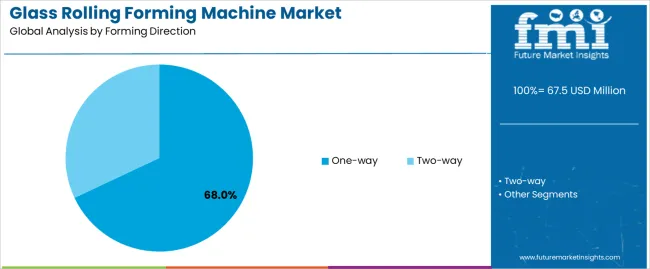
The One-way segment represents the dominant force in the market, capturing approximately 68.0% of total market share in 2025. This advanced category encompasses unidirectional forming processes, linear shaping configurations, and specialized rolling systems optimized for continuous production applications, delivering superior process control and manufacturing consistency in glass forming operations. The One-way segment's market leadership stems from its proven manufacturing efficiency, enhanced process reliability, and compatibility with diverse glass production requirements across building materials manufacturing, automotive glass production, and electronic display fabrication facilities.
The Two-way segment maintains a substantial 32.0% market share, serving applications that require bidirectional forming through complex shaping processes and specialized forming capabilities that provide enhanced versatility for custom glass products and specialized applications.
Key advantages driving the One-way segment include:

Building Materials applications dominate the market with approximately 45.0% market share in 2025, reflecting the extensive adoption of glass forming equipment across architectural glass production, construction material manufacturing, and building component fabrication. The Building Materials segment's market leadership is reinforced by widespread implementation in construction industry supply chains, architectural glass systems, and specialty building product manufacturing, which provide essential forming capabilities and quality consistency in construction-related glass production environments.
The Automotive Industry segment represents 28.0% market share through specialized applications including windshield manufacturing and automotive glass components. The Electronic Display segment accounts for 15.0% market share encompassing display panel production and electronic component fabrication. The Other segment constitutes 12.0% market share, covering diverse industrial applications including specialty glass manufacturing and custom forming operations.
Key market dynamics supporting application preferences include:
The market is driven by three concrete demand factors tied to manufacturing efficiency and product quality. First, construction industry expansion creates increasing requirements for architectural glass products, with global construction spending exceeding 13 trillion annually in major markets worldwide, requiring reliable Glass Rolling Forming Machine systems for building materials production, architectural glass manufacturing, and specialty construction applications. Second, automotive industry growth and safety enhancement initiatives drive adoption of precision forming technology, with glass rolling forming machines improving dimensional accuracy by 35-50% while reducing production variability in automotive glass manufacturing used extensively in windshield production and vehicle glazing systems. Third, manufacturing automation initiatives and production efficiency optimization accelerate deployment across glass manufacturing facilities, with Glass Rolling Forming Machines integrating seamlessly with automated production lines and enabling efficient material processing capabilities in high-volume manufacturing environments.
Market restraints include initial investment barriers affecting smaller glass manufacturers and cost-sensitive production operations, particularly where conventional forming methods remain adequate for basic glass applications and where capital budgets constrain adoption of specialized forming equipment. Technical expertise requirements for optimal process optimization pose adoption challenges for facilities lacking experienced glass engineers, as machine performance depends heavily on proper forming parameters, temperature control, and material handling that vary significantly across glass types and production requirements. Limited availability of specialized technical support in emerging manufacturing markets creates additional barriers, as glass manufacturing facilities require training in equipment operation procedures, maintenance methods, and process optimization to achieve target production levels.
Key trends indicate accelerated adoption in Asian glass manufacturing hubs, particularly China and India, where building construction activities and automotive manufacturing capabilities are expanding rapidly through government infrastructure programs and international investment in manufacturing development. Technology advancement trends toward intelligent control systems with automated parameter adjustment, energy-efficient heating technologies for reduced operational costs, and modular machine designs enabling scalable production capabilities are driving next-generation product development. The market thesis could face disruption if alternative glass forming technologies achieve breakthrough capabilities in production speed and cost-effectiveness, potentially reducing demand for traditional rolling forming systems in specific manufacturing applications.
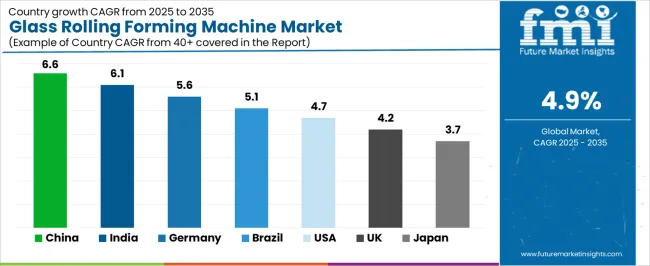
| Country | CAGR (2025-2035) |
|---|---|
| China | 6.6% |
| India | 6.1% |
| Germany | 5.6% |
| Brazil | 5.1% |
| U.S. | 4.7% |
| U.K. | 4.2% |
| Japan | 3.7% |
The market is gaining momentum worldwide, with China taking the lead to aggressive construction industry expansion and manufacturing development programs. Close behind, India benefits from growing infrastructure capabilities and government industrialization initiatives, positioning itself as a strategic growth hub in the Asia-Pacific region. Brazil shows strong advancement, where expanding construction operations and manufacturing infrastructure development strengthen its role in South American industrial supply chains. The U.S. demonstrates robust growth through advanced manufacturing initiatives and construction sector investment, signaling continued adoption in specialized glass forming applications. Japan stands out for its precision manufacturing expertise and advanced glass technology integration, while U.K. and Germany continue to record consistent progress driven by construction industry centers and glass manufacturing facilities. China and India anchor the global expansion story, while established markets build stability and technology leadership into the market's growth path.
The report covers an in-depth analysis of 40+ countries, top-performing countries are highlighted below.
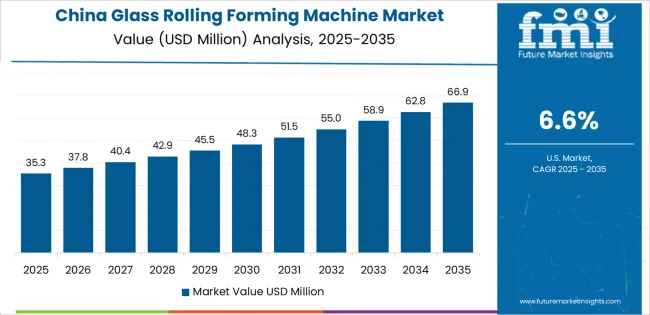
China demonstrates the strongest growth potential in the market with a CAGR of 6.6% through 2035. The country's leadership position stems from comprehensive construction industry expansion, intensive glass manufacturing development programs, and aggressive infrastructure modernization targets driving adoption of advanced forming technologies. Growth is concentrated in major manufacturing regions, including Guangdong, Jiangsu, Zhejiang, and Shandong, where glass manufacturers, construction material producers, and automotive companies are implementing glass rolling forming machine systems for production enhancement and quality optimization. Distribution channels through industrial equipment distributors, glass machinery specialists, and direct manufacturer relationships expand deployment across glass manufacturing clusters, construction material zones, and automotive production centers. The country's industrial modernization initiative provides policy support for advanced glass technology adoption, including subsidies for manufacturing equipment procurement and production infrastructure upgrades.
Key market factors:
In major industrial regions including Mumbai, Delhi, Bangalore, and Chennai, the adoption of glass rolling forming machine systems is accelerating across glass manufacturers, construction material facilities, and automotive operations, driven by government infrastructure initiatives and increasing focus on manufacturing competitiveness. The market demonstrates strong growth momentum with a CAGR of 6.1% through 2035, linked to comprehensive construction sector expansion and increasing investment in advanced glass manufacturing capabilities. Indian manufacturers are implementing glass rolling forming machine technology and modern production platforms to improve manufacturing quality while meeting construction requirements in industrial environments serving domestic and infrastructure markets. The country's Make in India initiative creates steady demand for advanced glass forming solutions, while increasing focus on construction modernization drives adoption of precision forming systems that enhance production efficiency.
Germany's advanced manufacturing sector demonstrates sophisticated implementation of glass rolling forming machine systems, with documented case studies showing 40-45% production efficiency improvement in glass operations through optimized forming strategies. The country's manufacturing infrastructure in major industrial regions, including Bavaria, Baden-Württemberg, North Rhine-Westphalia, and Lower Saxony, showcases integration of advanced forming technologies with existing glass production equipment, leveraging expertise in precision manufacturing and automotive glass production. German manufacturers emphasize quality standards and process optimization, creating demand for reliable glass rolling forming machine solutions that support production commitments and stringent quality requirements. The market maintains strong growth through focus on manufacturing excellence and facility modernization, with a CAGR of 5.6% through 2035.
Key development areas:
The Brazilian market leads in Latin American glass rolling forming machine adoption based on expanding construction operations and growing glass manufacturing infrastructure in major production centers. The country shows solid potential with a CAGR of 5.1% through 2035, driven by construction sector investment and increasing domestic demand for advanced glass forming equipment across building materials, automotive, and industrial sectors. Brazilian manufacturers are adopting glass rolling forming machine technology for compliance with international quality standards, particularly in construction applications requiring specialized glass properties and in automotive applications where forming precision impacts product performance. Technology deployment channels through industrial distributors, glass equipment representatives, and equipment financing programs expand coverage across construction supply chains and glass manufacturing facilities.
Leading market segments:
The U.S. market leads in advanced glass rolling forming machine applications based on integration with sophisticated manufacturing systems and comprehensive production platforms for enhanced operational efficiency. The country shows solid potential with a CAGR of 4.7% through 2035, driven by construction industry expansion and increasing adoption of advanced glass technologies across building materials manufacturing, automotive production, and specialty glass sectors. American manufacturers are implementing glass rolling forming machine systems for high-precision applications, particularly in architectural glass production demanding specialized forming capabilities and in automotive applications where dimensional accuracy directly impacts safety performance. Technology deployment channels through industrial distributors, glass machinery specialists, and direct manufacturer relationships expand coverage across diverse glass manufacturing operations.
Leading market segments:
The U.K. market demonstrates consistent implementation focused on glass manufacturing and construction material production, with documented integration of glass rolling forming machine systems achieving 32-38% operational efficiency improvements in manufacturing operations. The country maintains steady growth momentum with a CAGR of 4.2% through 2035, driven by construction industry presence and glass manufacturing requirements for advanced forming capabilities in specialized applications. Major industrial regions, including London, Manchester, Birmingham, and Scotland, showcase deployment of advanced forming technologies that integrate with existing glass manufacturing infrastructure and support quality requirements in construction and automotive supply chains.
Key market characteristics:
Japan's glass rolling forming machine market demonstrates sophisticated implementation focused on glass manufacturing and automotive production, with documented integration of advanced forming systems achieving 35-40% manufacturing consistency improvement in precision glass operations. The country maintains steady growth momentum with a CAGR of 3.7% through 2035, driven by manufacturing excellence culture and focus on quality optimization principles aligned with precision manufacturing philosophies. Major industrial regions, including Tokyo, Osaka, Nagoya, and Yokohama, showcase advanced deployment of specialized forming technologies that integrate seamlessly with automated glass manufacturing systems and comprehensive quality control protocols.
Key market characteristics:

The glass rolling forming machine market in Europe is projected to grow from USD 23.4 million in 2025 to USD 37.5 million by 2035, registering a CAGR of 4.9% over the forecast period. Germany is expected to maintain its leadership position with a 32.1% market share in 2025, declining slightly to 31.7% by 2035, supported by its extensive glass manufacturing infrastructure and major industrial centers, including leading construction material manufacturers and automotive glass production facilities.
France follows with a 18.6% share in 2025, projected to reach 18.9% by 2035, driven by comprehensive manufacturing facility modernization and construction development programs in major industrial regions. The United Kingdom holds a 15.8% share in 2025, expected to reach 16.1% by 2035 through glass manufacturing excellence and construction industry facilities. Italy commands a 13.7% share in both 2025 and 2035, backed by glass manufacturing programs and construction material operations. Spain accounts for 9.4% in 2025, rising to 9.6% by 2035 on construction expansion and glass manufacturing sector growth. The Rest of Europe region is anticipated to hold 10.4% in 2025, expanding to 10.6% by 2035, attributed to increasing Glass Rolling Forming Machine adoption in Nordic manufacturing institutions and emerging Central & Eastern European glass production operations.
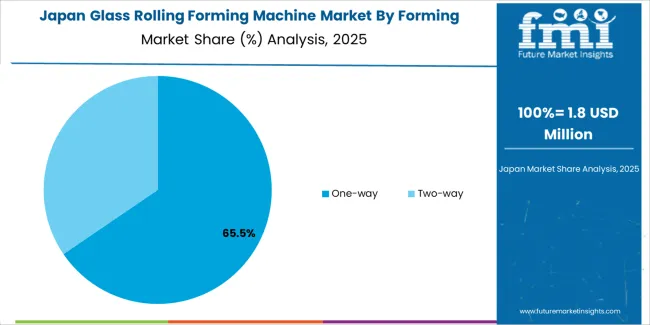
The Japanese market demonstrates a mature and precision-focused landscape, characterized by sophisticated integration of advanced forming systems with existing glass manufacturing infrastructure across construction material producers, automotive manufacturers, and specialty glass operations. Japan's focus on manufacturing excellence and production precision drives demand for forming systems that support quality commitments and dimensional accuracy targets in competitive glass manufacturing environments. The market benefits from strong partnerships between international machinery providers and domestic glass equipment distributors including major trading companies, creating comprehensive service ecosystems that prioritize technical support and process optimization programs. Manufacturing centers in Tokyo, Osaka, Nagoya, and other major industrial areas showcase advanced glass forming implementations where Glass Rolling Forming Machine systems achieve 93% dimensional compliance through optimized forming parameters and comprehensive quality control systems.

The South Korean market is characterized by growing international technology provider presence, with companies maintaining significant positions through comprehensive technical support and process optimization capabilities for glass manufacturing and construction material applications. The market demonstrates increasing focus on manufacturing automation and production enhancement, as Korean manufacturers increasingly demand advanced forming solutions that integrate with domestic glass production infrastructure and sophisticated manufacturing management systems deployed across major industrial complexes. Regional industrial distributors are gaining market share through strategic partnerships with international manufacturers, offering specialized services including technical training programs and application-specific forming solutions for glass and construction operations. The competitive landscape shows increasing collaboration between multinational machinery companies and Korean glass technology specialists, creating hybrid service models that combine international forming development expertise with local technical support capabilities and rapid response systems.
The market features approximately 12-15 meaningful players with moderate fragmentation, where the top three companies control roughly 45-52% of global market share through established distribution networks and comprehensive product portfolios. Competition centers on forming precision consistency, equipment reliability, and technical support capabilities rather than price competition alone. Fives Group leads with approximately 18.0% market share through its comprehensive glass forming machinery portfolio and specialized manufacturing expertise.
Market leaders include Fives Group, RUREX Stahl, and Torgauer Maschinenbau GmbH, which maintain competitive advantages through global distribution infrastructure, advanced forming technology, and deep expertise in glass machinery across multiple industrial sectors, creating trust and reliability advantages with glass manufacturers and construction material operations. These companies leverage research and development capabilities in forming technology optimization and ongoing technical support relationships to defend market positions while expanding into emerging manufacturing markets and specialized application segments.
Challengers encompass Fickert+Winterling Maschinenbau GmbH and Siping Hongda Yeya Machine Manufacturing, which compete through specialized product offerings and strong presence in key manufacturing markets. Product specialists, including FW, Huzhou JingDe Glass Technology Company, and Olivotto, focus on specific forming configurations or regional markets, offering differentiated capabilities in custom glass forming solutions, rapid delivery services, and competitive pricing structures.
Regional players create competitive pressure through localized production advantages and rapid response capabilities, particularly in high-growth markets including China and India, where proximity to glass manufacturing clusters provides advantages in technical support responsiveness and customer relationships. Market dynamics favor companies that combine proven forming performance with comprehensive manufacturing offerings that address the complete glass production cycle from equipment installation through process optimization and maintenance assurance.

| Item | Value |
|---|---|
| Quantitative Units | USD 67.5 million |
| Forming Direction | One-way, Two-way |
| Application | Building Materials, Automotive Industry, Electronic Display, Other |
| Regions Covered | Asia Pacific, Europe, North America, Latin America, Middle East & Africa |
| Country Covered | China, India, Germany, Brazil, U.S., U.K., Japan, and 40+ countries |
| Key Companies Profiled | Fives Group, RUREX Stahl, Torgauer Maschinenbau GmbH, Fickert+Winterling Maschinenbau GmbH, Siping Hongda Yeya Machine Manufacturing, FW, Huzhou JingDe Glass Technology Company, Olivotto |
| Additional Attributes | Dollar sales by forming direction and application categories, regional adoption trends across Asia Pacific, Europe, and North America, competitive landscape with machinery manufacturers and distribution networks, glass manufacturing facility requirements and specifications, integration with production systems and automated manufacturing lines, innovations in forming technology and control systems, and development of specialized machinery solutions with enhanced precision and efficiency capabilities. |
The global glass rolling forming machine market is estimated to be valued at USD 67.5 million in 2025.
The market size for the glass rolling forming machine market is projected to reach USD 108.9 million by 2035.
The glass rolling forming machine market is expected to grow at a 4.9% CAGR between 2025 and 2035.
The key product types in glass rolling forming machine market are one-way and two-way.
In terms of application, building materials segment to command 45.0% share in the glass rolling forming machine market in 2025.






Full Research Suite comprises of:
Market outlook & trends analysis
Interviews & case studies
Strategic recommendations
Vendor profiles & capabilities analysis
5-year forecasts
8 regions and 60+ country-level data splits
Market segment data splits
12 months of continuous data updates
DELIVERED AS:
PDF EXCEL ONLINE
Glass Liquor Bottle Market Size and Share Forecast Outlook 2025 to 2035
Glass Bottles Market Forecast and Outlook 2025 to 2035
Glass Restoration Kit Market Size and Share Forecast Outlook 2025 to 2035
Glass Bottle and Container Market Forecast and Outlook 2025 to 2035
Glass Additive Market Forecast and Outlook 2025 to 2035
Glass Reactor Market Size and Share Forecast Outlook 2025 to 2035
Glass Cosmetic Bottle Market Size and Share Forecast Outlook 2025 to 2035
Glass & Metal Cleaner Market Size and Share Forecast Outlook 2025 to 2035
Glass Product Market Size and Share Forecast Outlook 2025 to 2035
Glassine Paper Market Size and Share Forecast Outlook 2025 to 2035
Glass Container Market Size and Share Forecast Outlook 2025 to 2035
Glass Fibre Yarn Market Size and Share Forecast Outlook 2025 to 2035
Glass Cloth Electrical Insulation Tape Market Size and Share Forecast Outlook 2025 to 2035
Glass Bonding Adhesive Market Size and Share Forecast Outlook 2025 to 2035
Glass Mat Thermoplastic Market Size and Share Forecast Outlook 2025 to 2035
Glass Table Bacteria Tank Market Size and Share Forecast Outlook 2025 to 2035
Glassine Paper Industry Analysis in Western Europe Size and Share Forecast Outlook 2025 to 2035
Glassine Paper Industry Analysis in Korea Size and Share Forecast Outlook 2025 to 2035
Glassine Paper Industry Analysis in Japan Size and Share Forecast Outlook 2025 to 2035
Glass Mat Market Size and Share Forecast Outlook 2025 to 2035

Thank you!
You will receive an email from our Business Development Manager. Please be sure to check your SPAM/JUNK folder too.
Chat With
MaRIA